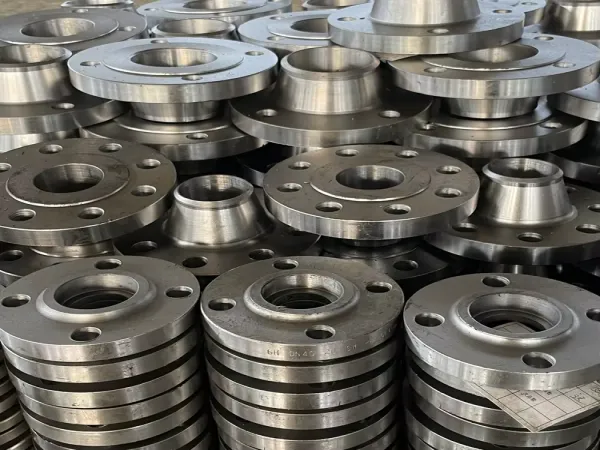Stainless steel flanges, as a disc-shaped part, are widely used in pipeline engineering, mainly for pipeline connection. It is usually used in pairs and installed with matching
flanges on
valves or equipment. In low-pressure pipelines, threaded stainless steel flanges can be used, while welded flanges should be selected in situations where the pressure is more than 4 kg. A sealing gasket is usually added between the two flanges and fastened with bolts. Depending on the pressure level, the thickness of the stainless steel flange and the required bolt specifications will also vary. Due to the wide range and complexity of application scenarios, there are many types of stainless steel flanges. Users need to make reasonable judgments based on the material, size, standard and specific use of the flange when choosing. So, what are the standards and types of stainless steel flanges?
Standards for stainless steel flanges
The standards for stainless steel flanges are divided into international standards, European standards, American standards and Chinese standards. Each standard has its specific scope of application and manufacturing requirements. Users need to make reasonable judgments based on specific circumstances when choosing. At present, there are many types of stainless steel flange standards, mainly the following:
Chinese standards: including GB (national standard), JB (Ministry of Machinery Standard), HG (Ministry of Chemical Industry Standard), etc. These standards are mainly applicable to the manufacture of pipeline engineering and related equipment in China.
International standards: Common ones are ISO standards, which are widely used in engineering projects around the world.
European standards: Including DIN (German standard), EN (European standard), etc., mainly used in pipeline engineering in European countries and regions.
American standards: Common ones are ANSI (American National Standard), ASME (American Society of Mechanical Engineers Standard), etc., which are widely used in America and other regions.
Japanese standards: JIS standards are mainly used in engineering projects in Japan and some Asian countries.
Korean standards: KSB standards are mainly used in engineering projects in South Korea.
At present, the most commonly used flange standards can be divided into two categories: one is the European system based on DIN standards, and the other is the American system based on ANSI standards. In addition, JIS standards belong to another independent standard system.

Common types of stainless steel flanges
According to different uses and installation methods, stainless steel flanges can be divided into the following common types:
Plate slip-on flange (PL): suitable for pipeline systems with lower pressure, simple installation and low cost.
Neck slip-on flange (SO): has better strength and stability than plate flanges and is suitable for medium pressure pipeline systems.
Neck welding flange (WN): Suitable for high-pressure and high-temperature pipeline systems, with firm connection and good sealing.
Socket welding flange (SW): Mainly used for the connection of small-diameter and high-pressure pipeline systems, easy to install and excellent sealing performance.
Threaded flange (Th): Suitable for small-diameter and low-pressure pipeline systems, simple installation and no welding required.
Butt welding ring loose flange (PJ/SE): Suitable for pipeline systems that require frequent disassembly, easy installation, but low strength.
Flat welding ring loose flange (PJ/R): Similar to the butt welding ring loose flange, it is suitable for low-pressure and non-corrosive medium pipeline systems.
Flange cover (BL): Used to seal the end of the pipeline and play a sealing role.
Material of stainless steel flange
Commonly used materials for stainless steel flanges mainly include the following:
316 stainless steel (CF8M): Suitable for corrosive media or extreme temperature environments, with a temperature range of -268℃ to +649℃.
347 stainless steel (CF8C): Suitable for high-temperature corrosive applications, with a temperature range of -268℃ to +649℃.
304 stainless steel (CF8): suitable for general corrosive or extreme temperature environments, with a temperature range of -268℃ to +649℃.
304L stainless steel (CF3): suitable for corrosive or non-corrosive media, with a temperature range of up to +425℃.
316L stainless steel (CF3M): suitable for corrosive or non-corrosive media, with a temperature range of up to +454℃.
The above materials all meet the ASTM A351 standard and are mainly used for castings, which are commonly found in the manufacture of valve materials.
Selection suggestions of flange
When selecting stainless steel flanges, reasonable choices should be made based on specific engineering requirements and use environments:
Consider working pressure and temperature: select pressure grade standards that meet the requirements.
According to the characteristics of the pipeline medium: select appropriate materials and anti-corrosion requirements.
Choose the appropriate connection method: select the corresponding flange type and standard according to the pipeline connection method.
Pay attention to the size and nominal diameter of the flange: ensure compatibility with the pipeline system.
Consider the project budget and long-term maintenance costs: select stainless steel flange products with high cost performance.
Stainless steel flange standards play a vital role in pipeline engineering. Correctly understanding and applying various standards is of great significance to ensuring the quality and safety of pipeline connections. Reasonable selection of stainless steel flanges that meet the requirements is a crucial step in pipeline engineering design and construction. I hope that through the introduction of this article, readers can better understand the standards of stainless steel flanges and make wise choices in practical applications.






 English
English Español
Español بالعربية
بالعربية











 Phone :
Phone :  Whatsapp :
Whatsapp :  Email :
Email : 


